New Walgreens Opens Inside a Historic Bank, Rather Than Raze It
Competition is heating up as retailers try to add locations in an effort to avoid stagnant sales growth. Having saturated suburban markets with their standard formula, they’ve been trying to do the same as they move into the urban core. Cities, more dense and often filled with vacant historic buildings, present new challenges to big retailers with one-size-fits-all formulas.
More than a dozen years ago a small group of citizens, myself among them, helped block Walgreens from razing the South Side National Bank (SSNB) at Grand & Gravois. “Put a Walgreens in the old bank”, we said to Walgreens officials. Unwilling to listen, they built a typical store across Gravois, but not on the corner.
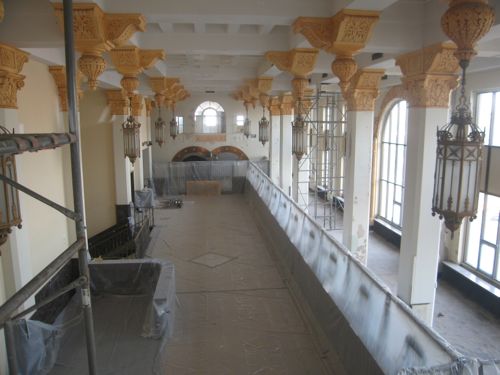
The Lawrence Group bought the SSNB, putting residential condos in the tower. Much of the retail space, including the magnificent lobby, remains vacant today.
A few years after attempting to raze the SSNB, Walgreens tried to raze the Gold Dome in Oklahoma City, located at NW 23rd & Classen.
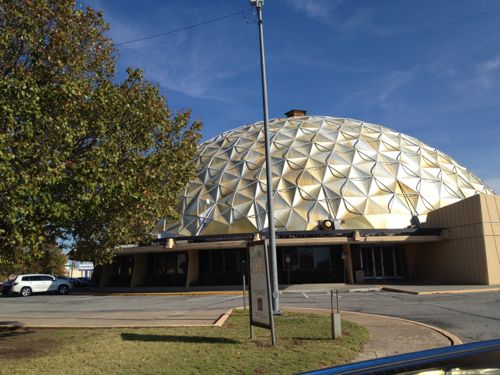
Walgreens was again met with citizen opposition:
Efforts to save the Gold Dome included picketing and marches, but in September 2001, a couple extended the efforts by writing a song. Also, an Oklahoma based company, Sonic Drive-In restaurants, offered up a billboard, located across the street from the Gold Dome, to the Citizens for the Golden Dome group. On the billboard was written “Stop the demolition of our historic landmark,” as well as the phone numbers for Bank One and Walgreens. (Wikipedia)
Today the Gold Dome is a central part of the neighborhood, now heavily inhabited by Chinese and other Asian nationalities, housing numerous businesses. Across one street is a typical CVS and across the other is a typical Walgreens, on the site of a former Beverly’s “Chicken in the Rough” restaurant.
In both cases a historic structure was saved, but the neighborhood was degraded by a standard suburban box(s). Both St. Louis & Oklahoma City didn’t care about anything besides the historic structure, or they were afraid to require something other than the standard prototype.
Fast forward a decade and we can look to a new Walgreens in Chicago that shows the retailer is willing to rethink their store design rather than forcing their standard box into a neighborhood. On a recent trip to Chicago this Walgreens was our first stop.
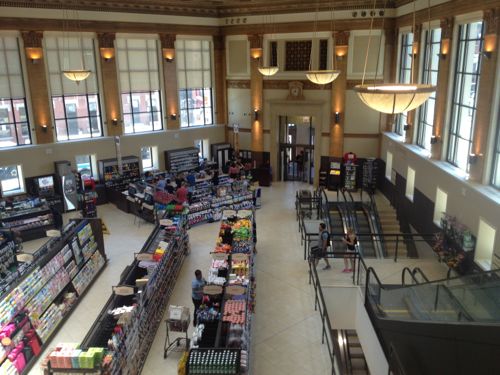
In the 45 minutes we were on site I took 70 pictures, my boyfriend quickly understood why a Walgreens was the first place I wanted to visit on our first trip to Chicago together:
The uber-fancy flagship is part of a plan by Walgreens–now the nation’s largest drugstore–to cater to a higher tax bracket while giving its more than 100-year-old brand a dose of modern edge.
Walgreens has recently launched several “upscale” stores, including a multi-level flagship in downtown Chicago and a massive concept store on L.A.’s Sunset Blvd.
According to Crain’s Chicago Business, the opening of the latest flagship, nestled between the Windy City’s trendy Wicker Park/Bucktown neighborhoods, will be followed by roughly 10 more upscale stores stores in locations ranging from Hawaii to the Empire State Building in New York. (Huffington Post)
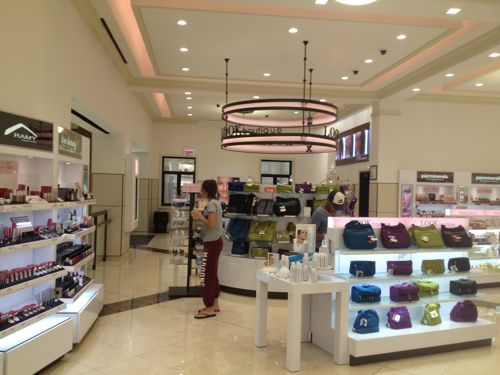
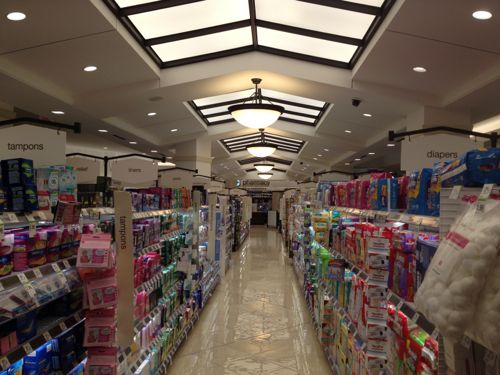
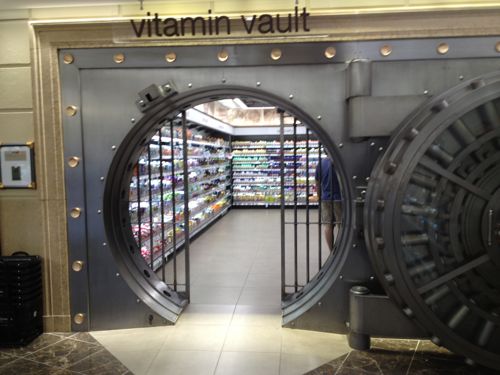
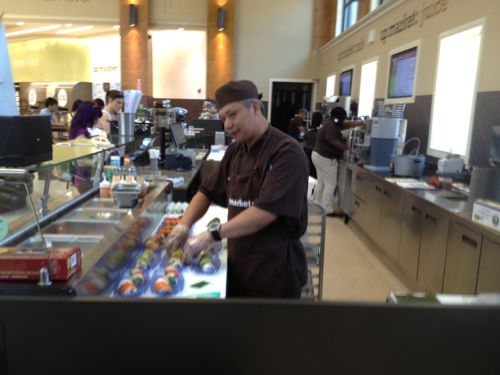
Now you might be thinking sure, in Chicago…developers are so much more enlightened in Chicago. Not so:
Many many years ago what is the Nobel Bank Building located at 1601 N. Milwaukee Avenue was, in fact, a bank. And more recently the building was the home of Midwest Bank; a full-service library quiet bank filled with friendly staff.
Several years ago, the building was bought by an investor with plans to add retail to that corner. His plans, however, were also contingent upon adding a massive parking garage right at the corner of North/Damen/Milwaukee. You can only imagine what that would have done to the traffic and congestion already filling the area. The end result would have been gridlock. Alderman Waguespak, thankfully, would not approve of the garage. So the investor abandoned the project.
The building sat vacant bordering on foreclosure. (source)
Developers, even those in Chicago, think massive parking garages are necessary in dense urban neighborhoods served by transit. True, even this Walgreens has an off-street parking lot.
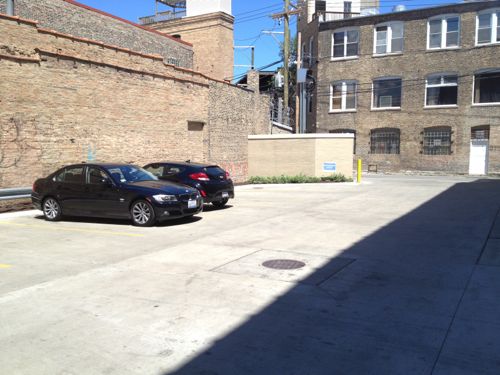
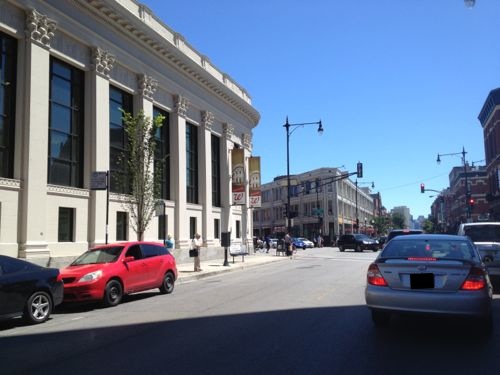
Chicago knows to not let auto-centric developers gut their neighborhoods, thereby achieving a balance among users. We’ve had decades of gutting our neighborhoods for parking, we must now reverse course.
Kudos to Walgreens on this store!
— Steve Patterson
Looks good – which historic building in Clayton or Frontenac will they putting this concept in, locally, to “–to cater to a higher tax bracket while giving its more than 100-year-old brand a dose of modern edge”?
Exactly what I was going to say. If it’s in a ritzy neighborhood, you can afford to spend extra on a unique building. Otherwise, no.
From the 2009 Wicker Park/Bucktown master plan:
“By the late 1960s, Division Street as well as the Milwaukee, North, and Damen six-point intersection were notorious for the presence of prostitution and an illicit drug trade. Shopping along Wicker Park and Bucktown’s commercial corridors all but ceased because “there was nothing to shop for.” Thus drained of residents and businesses, the new abundance of affordable properties and potential for business opportunities attracted an influx of Hispanic families, and by the close of the 1960s the ethnic composition of Wicker Park and Bucktown shifted significantly from predominantly Polish to Puerto Rican and later Mexican.
Attracted by the remnant spaces of Wicker Park and Bucktown’s industrial past, an appreciation of the local cultural arts history, and the coexistence of an eclectic mix of people and architecture, artists and arts organizations began reclaiming some of the neighborhoods’ abandoned spaces in the 1970s. This interest and influx coincided with a growing number of gay residents during that time. Their “urban pioneering” through the 1980s paved the way for a new era in Wicker Park and Bucktown, and the 1990s brought yet another demographic to the neighborhoods – the first of a wave of young professionals drawn by lingering low rents, a growing underground music and arts culture, and a gritty urban lifestyle in close proximity to transit. The early years of the 21st Century have marked a turning point in WPB’s unfolding history, bringing net growth to the neighborhood for the first time in decades.”
http://wickerparkbucktown.org/site/wp-content/uploads/2011/12/part-iia-1-wpb-context-demographics.pdf
Yeah, it was once poor, but now it’s a highly gentrified and fashionable area. From Wikipedia:
“In a September 2012 Forbes article, Wicker Park was named the #4 hippest hipster neighborhood in the country.[12] Property values have gone up, increasing the wealth of property owners and making the neighborhood attractive to real estate investors.””
“In the last quarter of the 20th century, a growing artists’ community led directly to widespread gentrification, which brought in a large population of young professionals. In recent years, many trendy taverns and restaurants have opened in [Bucktown]. There also have been a considerable number of “teardowns” of older housing stock, often followed by the construction of larger, upscale residential buildings.”
Yes, this shows neighborhoods can go from poor/vacant to expensive/in demand when you don’t gut them for auto-centric development.
You mean like the Central West End, Lafayette Square, Soulard, and one intsy, tinsy bit of St. Charles on Main street?
What was that line that I quoted?
“There also have been a considerable number of “teardowns” of older housing stock, often followed by the construction of larger, upscale
residential buildings.”
So they actually got rid of the old buildings.
Can someone define “hipster”? I have always benn curious as to
what it meant? I picture a nicely dressed hippie snapping his fingers
to “cool” music, while walking from his loft to the coffee shop.
Interested in hearing more about the small group of citizens that worked to save the SSNB building. From what I remember, there was a coalition involved, called the “Grand and Gravois Coalition”. The Grand and Gravois Coalition was made up in part by members of MCU (Metropolitan Congregations United). Jennifer Florida was involved in the effort. Her efforts to help save the SSNB is part of what launched her political career. I can’t remember anyone else who was involved, but I thought it was a pretty big deal. In those days, MCU launched massive campaigns with hundreds of people getting involved.
I submit that Chicago has more flexibility when it comes to not bowing to “auto-centric developers” as the city has a vast public transit infrastructure. Developers in StL don’t have that luxury. This is a commuter town, pure and simple, and any developer looking to build would be negligent if they didn’t consider ample parking. If there were a lot more people who lived and worked in the city then I could see a reduction on the premium placed on parking but that really isn’t the case and public transit in StL just doesn’t meet the needs of our commuter culture and in most cases driving yourself is way more efficient. I live in St. Louis Hills and work in Creve Coeur; so my choices are spending either an hour and twelve minutes on public transit (per Google Maps) or spending twenty minutes in my car. Let’s say I wanted to go downtown; I can either spend fifty four minutes on public transit or seventeen minutes in my car. I sure hope they have parking, because to not drive would be dumb.
stl hills, Snore!!!, might as well be the county
Thank you. St. Louis Hills is a bore. The neighborhood hardly even identifies with the city. The people there are more concerned with preventing change than fixing problems. Look at that remodel of Johnny Gittos grill on Watson next to River Des Peres (technically Lindenwood Park neighborhood, but what’s the difference?). Awful! That metal fence dividing patrons from the street is horrible. How did that ever get past the city or the neighborhood groups? It looks like an exercise yard for prison inmates. Steve should do a poll about St. Louis Hills.
So you criticize St. Louis Hills by giving an example of a place you don’t like in another neighborhood? Uh, OK.
Wump, you need to self-administer a good old fashioned vinegar enema.
Ill take colon care advice from you when I take urban planning advice from someone from stl ‘ills; when hell freezes over, when pigs fly, when I move to the County… ie NEVER! Go bake to maplehood or newtown or where ever you are faking it.
St. Louis Hills is a great neighborhood and I love living there. I am not sure why you see fit to look down on it.
top two: (i have about a million) #1 its boring #2 the drivers there are the biggest ass holes ive ever seen. I get more respect as a pedestrian in parks of the County for gods sake. Ever time I am in the cross walk @ chippewa and jameson, with the walk sign, some jerk cuts me of, gives me the finger, and calls me a scum bag for not having a car. christ, move to south county already. or how about chippewa and landsdowne, no cross walk, no walk sign, its impossible to tell if the cars coming have the arrow or not, and even if they do they think they have the right of way. stl hills, bringING the county to the city for too long.
It sounds like perhaps you are exaggerating for effect. I have walked both of those intersections many times and never had the types of problems you have.
Why do you think St. Louis Hills is boring?
Well then move. New Town in St. Charles should be exciting for you. And it’s designed to be walkable.
Yes, I was there right after the grand opening. I just happened to be in Chicago on business and was lured in by a WGN local news story about the new Wicker Park store. It was pretty awesome, especially the “Vitamin Vault” and the displays of historical Walgreens merchandise. But, ya know, it’s still a Walgreens, and it’s only a half-block from the Damen stop on the Blue Line. Great pictures though! 🙂
I do think the Walgreens that was built on Gravois at Grand could have done with about half as much parking space. I know they wanted a driveway from Grand, but those parking spaces are never occupied. Also that is a very transit-accessible location, by South St. Louis standards – the #70 Grand, #73 Carondelet and #10 Gravois Lindell all stop close by.
Personally, I still use transit on a near-daily basis for commuting – even though I now live 50 feet into South County. But it is true, rather than stopping somewhere along the way I do usually get in the car to go to stores or restaurants, after walking about a 1/2 mile home from the bus stop. The problem with transit in St. Louis isn’t rush hour — it’s perfectly adequate then, with most bus routes running every 20-30 minutes and MetroLink even more often. It’s after 7 pm and on weekends, when service is sparse and requires pre-planning, even on MetroLink and main routes like Grand and Kingshighway. So, yes, going to the grocery store, drug store, or to dinner is most easily accomplished by car for many (most?) people, even in the city and inner-ring suburbs.
Within 45 minutes of arriving? Seriously? I would put it on my list of must sees, and I love the Vitamin Vault and other views, but really??? On your first trip together to Chicago? I get your love of urbanism Steve, but your partner must have the patience of a saint! LOL
I think it’s great to reutilize these gems in any city. Gems that are testaments to the greed of generations past btw. Flashy and showy. Interesting and ironic that the examples you site have all been banks! One doesn’t walk into a Wells Fargo or even a Commerce Bank or SL Credit Union and find architecture like this anymore.
I don’t think it’s so much “enlightened” developers than it is “how can we differentiate our selves from our competitors”. Building the customer base was primary, hence the standard, cost controlled big box building. But now it’s evolved from that to standing out from the big boxes.
It fit into our schedule at first. Later that night we had drinks on the 7th floor roof terrace at the Hyatt, dinner at the Signature Lounge, and a play in the Loop.
Enlightened or differentiate, retailing has changed. We need to understand this change and use it to our gain.
“use it to our gain”….who’s gain is that? The city (any city really) that gives away TIFFs? the urbanist? or the customer that could care less as long as they don’t have to walk more than 10 feet and pay the cheapest price they can (ie the wally worlds). Ah, there is the rub.
But glad you enjoyed your trip to the Windy City!